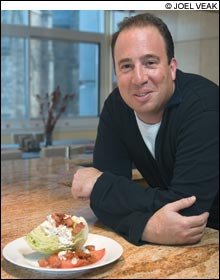
Michael Schlow
|
As I tucked in to the roast chicken at Hamersley’s Bistro recently, I chided myself for ordering it. Not because it wasn’t good (it was), but because almost every time I eat at Hamersley’s, after a little tug of war with myself for my lack of adventurousness, I wind up ordering the roast chicken. It’s stupid — the restaurant excels at everything, and I order the most pedestrian dish on the menu. But suddenly I got it: Hamersley’s roast chicken is my yardstick dish, the thing I use to judge every other bistro I visit. If a restaurant can produce a bird that’s as good as Gordon Hamersley’s, my internal food critic decides that it’s a pretty darn good place.
I’m not the only one who does this. Some people use Caesar salad, some use onion rings, others use spaghetti with fresh clam sauce. I use roast chicken because it’s a dish I’ve eaten often enough to be completely judgmental about it. Chris Kimball, the founder and editor of Cook’s Illustrated, said something to me that I’ll never forget: he questioned why Americans are always cooking recipes that call for exotic spices. He wondered how many of us have eaten enough Indian food to know a good rogan jhosh from a mediocre one. But a pot roast? We’ve all eaten enough pot roasts to tell a good one from a lousy one. That’s our internal critic speaking, the voice that says, Hey, I’ve had this dish before, and this one tastes better than what my grandmother ever made.
I was curious to see if Boston’s best chefs also have dishes they order around town and around the globe to figure out if the people behind the swinging kitchen doors know how to cook. Often, the dish comes from a first fabulous experience. For Rialto chef Jody Adams, the quintessential Italian dish is the first one she ever ate in Italy as a teenager: fresh pasta with clams, garlic, tomatoes, and red-pepper flakes. “I’d never tasted anything that good before in my life,” she says. “It blew my mind and became my barometer. Now, I order it all the time because I love it. For me, a simple pasta dish like that is like a green salad. If a chef can screw up a simple green salad, they just aren’t paying attention.”
Summer Shack’s Jasper White agrees that our internal food critic is molded by our life experiences. “Good food or bad food is totally subjective — as it should be,” he says. But, he notes, “what we like might be how grandmother made something, or the first time we ate something. It’s hard for a restaurant to compete with a romantic notion from childhood.”
Via Matta/Radius chef Michael Schlow has a whole list of un-fancy dishes that speak to his internal critic. He still loves those New Jersey restaurants he went to as a bridge-and-tunnel kid; his barometer for Japanese restaurants is “a hole-in-the-wall in Jersey across the mall from the photo shop and the dry cleaner” called Shumi, where they make sashimi so tender, Schlow still swoons. He says that it’s the rice in the sushi or sashimi that really tips him off to the quality of a Japanese restaurant. It should be served room or body temperature, not hot, and have exactly the right texture: not too crunchy or too starchy. “A good Japanese chef makes fresh rice all night long,” Schlow says. At steak houses, he searches for the perfect wedge salad, and uses the side dishes and the steak au poivre as his yardsticks (he uses steak au poivre at French bistros, too). At Szechwan Chinese restaurants, it’s spicy string beans, hot-and-sour soup, and the tenderness of the dumplings. (“Did they buy them frozen or make them in-house?”) Schlow’s big question at Italian restaurants: “Can they make a good bowl of pasta? Italian chefs spend years learning how to make perfect pasta.” At modern French bistros, it’s steak frites, seafood plateau, and frisée-and-lardon salad with poached egg. And at seafood restaurants, Schlow uses fresh oysters with mignonette sauce (if the oysters come only with cocktail sauce, the place is a goner), and a lobster roll.
Lumière chef Michael Leviton says the easy dishes are often the hardest to execute. When he eats out these days, it’s mostly Asian food. His Chinese barometers are salt-and-pepper shrimp and broccoli with garlic sauce. “Simple dishes,” he says, “but not so easy to get a good one — the sauce can be too thin or watery or all gunked up with too much cornstarch.” Thai food is Leviton’s daughter’s favorite, so he’s getting good at judging pad Thai, drunken noodles, and short ribs served with curry and sweet potatoes. “A good one has all the right flavors: rich, hot, sour, and sweet,” he notes. The firmness of the rice is Leviton’s tip-off when eating Japanese, and risotto is his test for Italian restaurants: “It has to have the right combination of creaminess, toothy but not crunchy … not so easy to pull off a good risotto.”
So what’s your personal yardstick when eating out? We need professional food critics to point us to the new and different, sure. But when it comes to our barometer dishes, our own internal critics know instinctively whether the food is four-star or a flop.